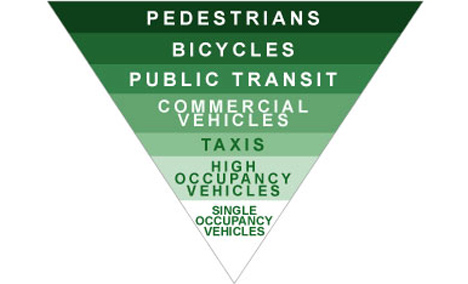Implementing a Personal Transportation Hierarchy
There’s a concept in urbanism and sustainability that I recently learned about from the CityNerd YouTube channel called the green transportation hierarchy, which looks like this:

The idea is that things lower on the pyramid should defer to the things above them and that our environments should be designed to make more sustainable forms of transportation easier than less. It’s the difference between a pedestrian hostile strode and the kind of environment you might see in a place like Barcelona.
To me, this idea makes sense in a couple of ways. If you want people to make sustainable choices that make cities more livable, you need to make those choices more convenient than the alternatives. If getting across town on a bus takes ninety minutes and driving takes ten, it’s not hard to understand why people choose to drive.
So what’s the personal part of this? The thing is, between 2009 and 2017, I didn’t own a car at all. During that time, I moved from Portland, where it was kind of annoying but doable, to San Francisco, where having a car seemed like a burden more than anything else, to Seattle. I could have continued in Seattle, but it would have been more difficult than in other places I’d lived, and so I got a car a few months after moving there. I still took the train when it was more convenient but less than before.
The next place I lived was Silicon Valley, specifically Cupertino and Campbell. I’d walk or ride my bike when it made sense, but that area was not designed to get around without a car. At this point, I was driving more than anything else. After the pandemic started, riding a bus or on a train became something I wouldn’t do.
Since then, I’ve come back to Portland, and the options to get around without a car are better again. Portland has a pretty good bike share program, an above average light rail system, and an okay bus network. Plus, my neighborhood is pretty walkable, with a 73 walk score. I’m lucky to live in a place with all these things available and accessible to me, but after getting used to driving as a default, I haven’t used them as much as the last time I lived here (without a car).
Here’s my plan. If where I’m going can be walked to in under 20 minutes or so, I’m going to do that. I’ll bike if it’s further or I’m in a hurry. If it’s further than I’d like to cycle to, I’ll take the bus. Portland still has a lot of sprawl, so cutting out driving 100% would be hard. The goal is to reserve driving for when I need to get something I couldn’t otherwise take back or when taking public transit would take a lot longer than I have. I really want to break the habit of driving being my default mode of transportation.
I’ll let you know how it goes.